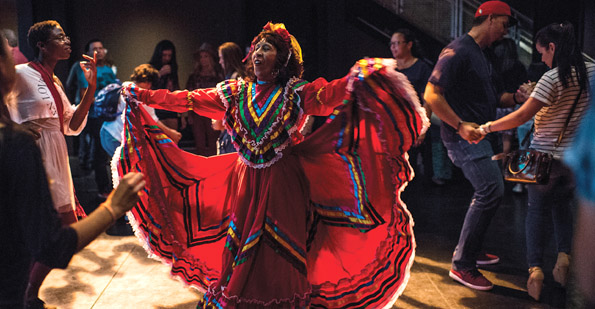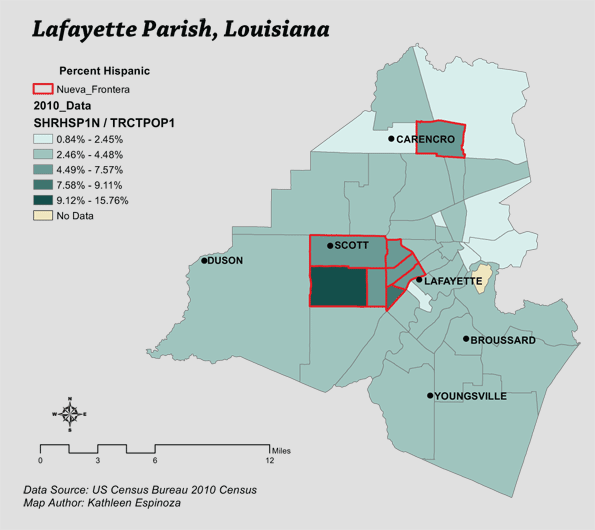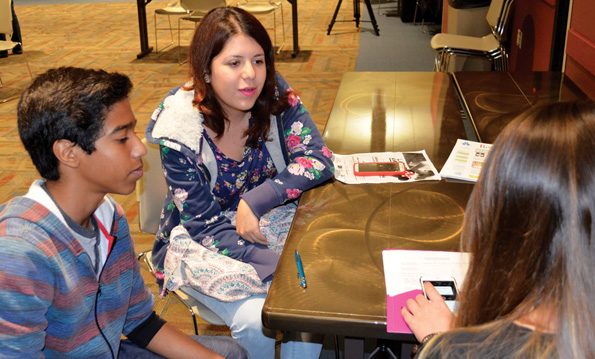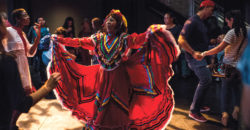Magazine
La Nueva Frontera: Oral Histories from the Latino Communities of Lafayette
A professor and her students record nearly 100 different oral histories of Latino immigrants living in the Lafayette area
Published: March 1, 2016
Last Updated: September 11, 2020

Photo by Paul Kieu
Cuca Rubin perfroms at the 2015 ACLA Latin Music Festival held at the Acadiana Center for the Arts in Downtown Lafayette, LA.
This article is part of “Latino Americans in Lafayette,” a project coordinated by the Louisiana Endowment for the Humanities. The LEH received a grant from the National Endowment for the Humanities and the American Library Association to produce a series of public programs in Lafayette 2015 and 2016. The LEH’s partners for the project include Lafayette Public Library System, Asociación Cultural Latino Acadiana, Edith Garland Dupre’ Library, Lafayette International Center, and the Consulate General of Mexico.
When someone in my family celebrates a birthday, we sing the “Happy Birthday” song twice, once in English and once in Spanish. My husband is a Chilean-born immigrant to the United States, and, as parents raising a family in Lafayette—the anchor for francophone Louisiana—we try to encourage a strong connection to our extended family in Chile, fostering roots that are both North and South American. The decisions we make in our home about language, music, food, stories, and travel are driven by a desire to ensure that the lives of our children include the diversity of their heritage.We are not alone. My family and I share our future with an emerging community in Lafayette that identifies with the larger Latino world. Currently there are more than 10,000 Latino immigrants living in Lafayette, each of them deciding how best to survive and belong. They are teachers, students, homemakers, entrepreneurs, and artists. Examining how they use private and public space is critical in our understanding of a larger cultural evolution that challenges the view of South Louisiana as exclusively “Cajun Country.”
Over the past five years, with the help of my geography students at the University of Louisiana Lafayette, I have archived in the Center for Louisiana Studies nearly 100 different stories of Latino immigrants living in the Lafayette area. They graciously agreed to open their homes, their businesses, and their classrooms to help us understand the nature of adapting to a new community and the roles each of us plays in the evolution of Lafayette in the New South.
Lafayette’s new geography
Lafayette Parish, home to more than 230,000 people, sits at the intersection of Interstates 10 and 49. Once described as a “hub city,” Lafayette is a regional nexus of oil and gas services, higher education, and healthcare—industries that generate robust demand for both skilled and unskilled labor. Across the South, smaller cities like Lafayette are now drawing immigrants away from larger traditional gateway cities where jobs, housing, and a better quality of life are becoming more difficult to attain. Contributing to Lafayette’s unique patchwork is the Catholic Diocese of Lafayette—an affiliate of Catholic Legal Immigration Services. For more than 40 years, the diocese has assisted in the resettlement of people from countries such as Cuba, Nicaragua, Colombia, Venezuela, Honduras, and El Salvador, who seek refuge from political persecution, natural disasters, and economic collapse.
Meeting the needs of the burgeoning immigrant population is not easy.

The Lafayette Parish School System has expanded its English as a Second Language (ESL) program to accommodate the growing population. The majority of the program’s 2,000 students are children of Latino origin, particularly in the western parts of the parish. Scott, a small municipality six miles west of Lafayette, heralds itself as “where the West begins.” With its Hispanic population clusters and a scattering of Latino grocers and shops, it might be more aptly named La Nueva Frontera.
For the immigrant, adjusting to life in Lafayette presents numerous challenges. Georgina, an immigrant herself and a specialist with the school system’s ESL program, explains:
I would like to see more people understand where and why the immigrants are here. Most people believe that every Latino is Mexican, which is not the case at all. Most of our Latino students are from Central America and have come because they want a better life for their families… It is an expensive and dangerous journey for these children. They work hard for little money with the hope that their next generation will have a better life…
Navigating Lafayette’s small city services can be burdensome. Some immigrants find themselves without adequate public transit to manage a job or to pick up a sick child from school and take them to the doctor. And even some of our participants who have cars face a transition to a smaller city environment:
In Mexico I did not need a car, I had one but it was not necessary. I could go out fast, five minutes walking, I got into a bus and it took me wherever I wanted for five pesos. It took me to the places I wanted, I got used to…the subway, take a walk here and there, people walking everywhere, I miss that a lot from Mexico. —Marco
Encounters with “Geaux” and the Disappointments of Taco Bell
Many immigrants we interviewed desired to find a balance, to let go of what is familiar and negotiate a path to a new sense of belonging. Obstacles include Lafayette’s francophone-inspired dialect and the foodways of South Louisiana.
I didn’t even know what Cajun was, what Cajun French was and you know that word that I would see everywhere… “g-e-a-u-x” and I was, “what the heck is that?” I got to find later that it was “go”. I don’t know why people here would want to spell “a-u-x” at the end of the word. I guess it’s French. I still have to find out for myself. Also the food that is eaten here is very different from the (food) I am used to. I never had alligator before, frog legs, or crawfish and now I also can say now that I tried all of these kinds of different foods. Crawfish is not that bad, but I am not sucking the heads any time soon. —Sherry
Even our not-so-exotic cuisine causes some consternation.
You get out of a club in Mexico and then go eat tacos from a street vendor…First time I saw a Taco Bell I was really excited until I saw these crunchy things with cheese and said, Is this what Americans really think we eat? We are so close in geography, but (they) have no idea what we eat. —Flor
Modern theories of assimilation are rooted in the larger socio-economic factors facing a particular immigrant. For our project, however, we were concerned largely with the rituals of daily life: meals, prayer, hobby, and recreation. We searched for a better understanding of the differences that matter to the Latino immigrant.
There is probably no larger obstacle to fitting in than communication. Several of our participants talked about experiencing discrimination because of their accents. Some lamented not being able to talk freely with their children’s teachers, and others felt a sense of isolation from their in-laws and extended families. But many expressed pride in their perseverance.
Well, it’s hard at first. I think the language is one, like a big fence, you know, that can stop you if you’re not able to climb it and go…The family and everything you left behind to come here and I think that is the (price) you pay. But once you… (are) around people and know them and get more into the culture, you know, you start to feel part of it, like you start sharing traditions. So at one point you start building memories here. Because I think that’s the hardest part, that at first you think that you don’t belong. —Kathy
A Diverse and Dispersed Population
Lafayette’s Latin American population is a 21st century mosaic of perspectives, traditions, and backgrounds. Mexico, Honduras, and Cuba represent the largest groups, but the populations from Venezuela, Colombia, El Salvador, and Guatemala are growing. Despite their different nationalities, the qualities that bind them together—the Spanish language and the immigrant experience—are often enough to forge a sense of community in various venues.
Francisco, for example, found belonging through his love for soccer.
I play soccer all over Lafayette. Until I started playing soccer, I really never met anyone else from Honduras or any neighboring countries, and now I have met so many Spanish-speaking people that it’s helped me stay in touch with my culture.
Geographers have a term, heterolocalism, that refers to the points of encounter for immigrant communities in their host countries. The propensity for physical clustering of ethnic groups, as seen in traditional gateway cities, is less of a factor in Lafayette today as mobility, communication, and services facilitate community building in disparate parts of the city. Public spaces, both brick-and-mortar and cyber, provide the unique geography for various encounters.
La Morenita, a popular local Latino grocery and lunch spot, not only provides familiar food, but it allows people to wire money to families far away and provides a gathering space for friends to share the happenings of the area. Raphael, a Cuban restauranteur, opens his eatery up on Fridays for a Latino dance night. Several different local Facebook groups provide places for like-minded Latino communities to share information. Meanwhile, a handful of churches in Lafayette, both Catholic and non-denominational, assist Latino immigrants in adapting to life here and provide a venue for celebrating community.
We have the Spanish Mass. Every Saturday we go here, Our Lady of Wisdom. We have the mass every Saturday in Spanish. And every Sabbath day of the month, we celebrate the (birthdays)… So everybody brings some food of your country because we have Cubans, Colombians, Venezuelans, and Mexicans. We bring food that we eat and we share. So far we are keeping traditions… —Piedad
In 2000, with assistance from the Lafayette Consolidated Government’s International Center, a small group of volunteers organized The Asociación Latino Cultural-Acadiana (ACLA). Through its website, the non-profit group provides practical information to Latino immigrants. Each October, ACLA hosts a large festival in Lafayette featuring music, food, and crafts from local groups. The event marks a coming out, so to speak, for the local Latino community in the city’s historic downtown, traditionally a focal point for the celebration of the region’s francophone roots. Finding common ground among Latino and francophone advocates is critical.

Yahveh Briseño and Joseph Bledsoe from Anaco, Venezuela recount and record their personal experiences and stories in celebration of Latino American Oral History Day at the Lafayette Public Library, November 7, 2015. Photo by Romy Mariano
Making a Home
For the past several decades, francophone place-makers—including educators, musicians, and chefs—have led to a transformation of Lafayette’s cultural economy by emphasizing the Acadian history of the region. These efforts have outpaced the reality, as the majority of people living in Lafayette do not necessarily identify with a French heritage. The promotion of French culture has been important to the diversification of the regional economy and, perhaps less measurable, is central to the creation of Lafayette as a hip place to be. But it is an assertion of an identity, embracing aspects of the traditional remain that open to modern interpretations. The South Louisiana Cajun or Creole is a 21st century sophisticate—one who recognizes that culture and an economy derived from it—and must be open to new flavors.
In much the same way, members of Lafayette’s Latino community are finding ways to assert parts of their own identities into the larger cultural milieu. Diego, a young sophisticate himself, hosts a Latino music program, La Vellonera, on the local public radio affiliate, KRVS—Radio Acadie, a station noted for its commitment to local French programming.
So I come to find that you hear music and eat the food and feel the atmosphere of cultural events…they are much related. I feel like there is a bridge that has not been built between the Latino and Cajun people. We’re not that different, and I feel something needs to be done about it. Our organizations are trying to do that. I have a radio show where I play Latino music and I try to either show people how good the music is. Not only that, but also (show) how similar it is (to Cajun music). —Diego
Negotiating connections is vital to feeling part of an established community, yet the construction of place is a complex process and one that is inherently personal. Kitchens and living rooms are intimate venues carrying language and food traditions to subsequent generations, that when open to an outsider, educate us on the personal evolution of the Latino in Lafayette. It is an evolution that reveals both a pride and effort on the part of the immigrant.
I always cook my food. My family now learns to eat my food like arepas, sancocho, tamales, like I learned to eat the food from here. That’s the mix, the two kinds, respect two foods. A mix pot… You don’t have to forget where you come from, that is one other thing, and they are not going to forget where I came from. I’m so proud for my country, for Colombia. It doesn’t matter what they say, I’m proud of my country, and I’m proud to be here too. —Piedad
And for Diego, home is where he shares what is most important to him as a Latino living in Lafayette.
I’m proud of being a Latin American, that’s for sure, but I don’t feel like I have to go run around in the park or anything like that to show people that I am. I play Latin music from time to time. I have a radio show, and I cook the food of my people for my friends. I like to have people over to show them pictures or recipes from my grandfather’s book, music from my grandfather’s record collection. That is my cultural activities—I create my own.
—–
Kathleen Schott Espinoza has 20 years experience as a Geography educator, and currently is a faculty member of UL Lafayette’s History, Geography and Philosophy Department. Her teaching and research interests include: cultural and political geography, Latin America and K-12 education.
